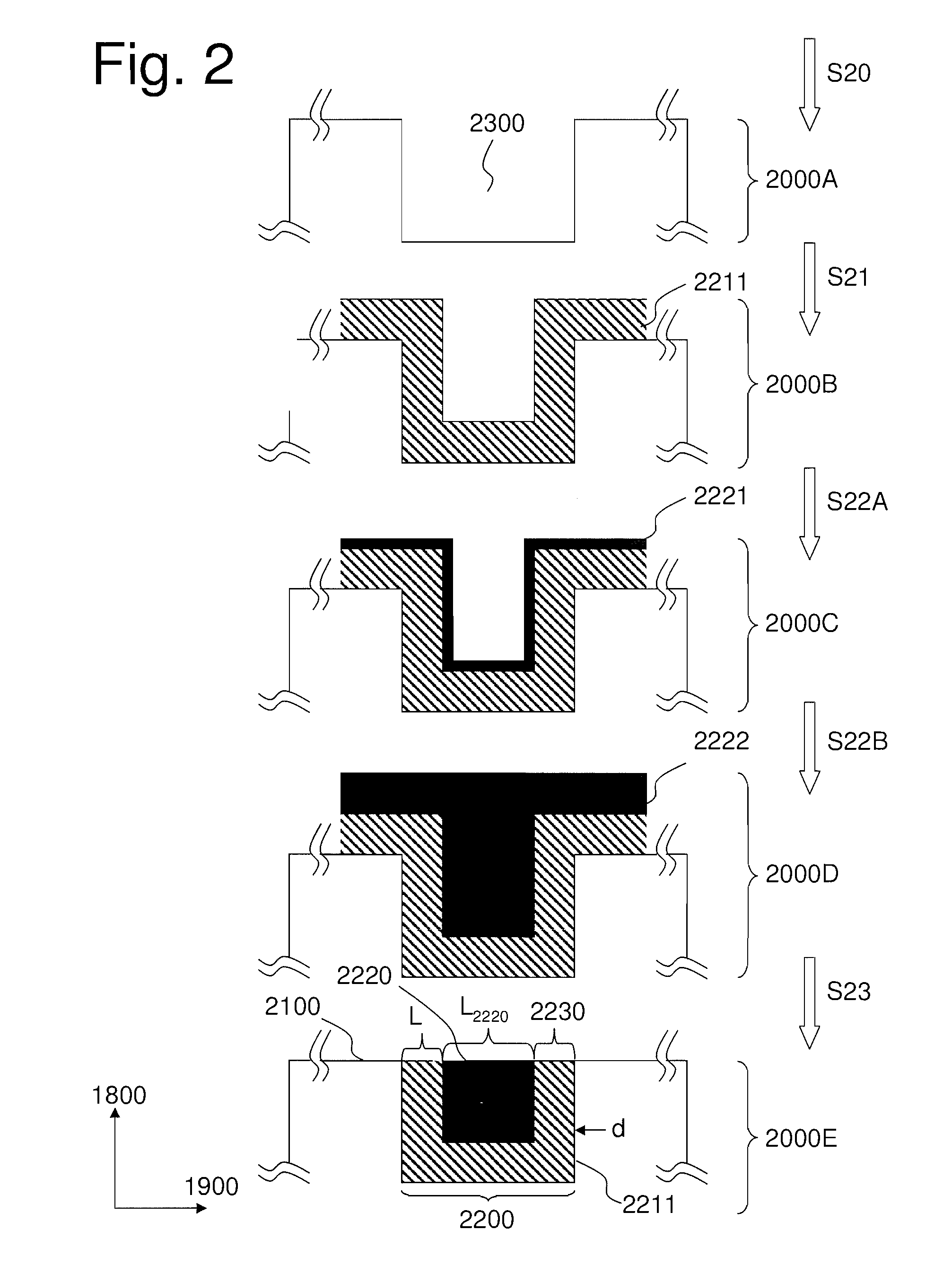Process for realizing a connecting structure
a technology of connecting structure and process, which is applied in the direction of semiconductor devices, semiconductor/solid-state device details, electrical apparatus, etc., can solve the problems of limiting the application of such techniques, limiting the manufacturing limit of classic semiconductor technology, and difficult to achieve perfect alignment as shown in fig. 8b, so as to prevent the dispersion of metal composing the connecting structure
- Summary
- Abstract
- Description
- Claims
- Application Information
AI Technical Summary
Benefits of technology
Problems solved by technology
Method used
Image
Examples
first embodiment
[0071]FIG. 2 is a schematic drawing illustrating a process for realizing a connecting structure according to the present invention. More specifically, FIG. 2 illustrates a process of realizing a connecting structure 2200 such as connecting structure 1201 of the first semiconductor substrate 1000, and / or connecting structure 1202 of the second semiconductor substrate 1700, and / or any of connecting structures 1200 of FIG. 1.
[0072]A semiconductor substrate 2000A includes a hole 2300, as can be seen in FIG. 2. The hole 2300 might be realized starting from a semiconductor substrate through step S20, by carrying out, for instance, photolithography and etching. The size, shape, depth and position of hole 2300 might be controlled in a manner known in the art of semiconductor manufacturing.
[0073]By carrying out a deposition and / or growing step S21, a diffusion barrier layer 2211 is realized on top of semiconductor substrate 2000A so as to obtain semiconductor substrate 2000B. The realization...
second embodiment
[0089]FIG. 4 is a schematic drawing illustrating a process for realizing a connecting structure 4200 according to the present invention. More specifically, FIG. 4 illustrates a process of realizing a connecting structure 4200 such as connecting structure 1201 of the first semiconductor substrate 1000, and / or connecting structure 1202 of the second semiconductor substrate 1700, and / or any of connecting structures 1200 of FIG. 1.
[0090]As can be seen in FIG. 4, a semiconductor substrate 4000A having a first hole 4320 and a second hole 4310 encircling the first hole toward the surface 4100 could be obtained by a step S40. The first hole 4320 might be realized starting from a semiconductor substrate through step S40, by carrying out, for instance, photolithography and etching. The size, shape, depth and position of first hole 4320 might be controlled in a manner known in the art of semiconductor manufacturing. Similarly, the second hole 4310 might be realized starting from a bulk semicon...
third embodiment
[0097]FIG. 5 is a schematic drawing illustrating a process for realizing a connecting structure 5200 according to the present invention. More specifically, FIG. 5 illustrates a process of realizing a connecting structure 5200 such as connecting structure 1201 of the first semiconductor substrate 1000, and / or connecting structure 1202 of the second semiconductor substrate 1700, and / or any of connecting structures 1200 of FIG. 1.
[0098]FIG. 5 illustrates a semiconductor substrate 5000A with a conductive layer 5220 and a diffusion barrier layer 5212 achieved by a step S52. Techniques for carrying out step S52 could be substantially similar to techniques for carrying out steps S22A and S22B in FIG. 2.
[0099]Subsequently, a semiconductor substrate 5000B having a hole 5310 on the diffusion barrier layer 5212 surrounding the conductive layer 5220 or near the surface 5100 is obtained by a step S50. The size, shape, depth and position of hole 5310 might be controlled in a manner known in the a...
PUM
 Login to View More
Login to View More Abstract
Description
Claims
Application Information
 Login to View More
Login to View More - R&D
- Intellectual Property
- Life Sciences
- Materials
- Tech Scout
- Unparalleled Data Quality
- Higher Quality Content
- 60% Fewer Hallucinations
Browse by: Latest US Patents, China's latest patents, Technical Efficacy Thesaurus, Application Domain, Technology Topic, Popular Technical Reports.
© 2025 PatSnap. All rights reserved.Legal|Privacy policy|Modern Slavery Act Transparency Statement|Sitemap|About US| Contact US: help@patsnap.com



